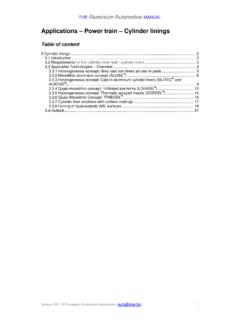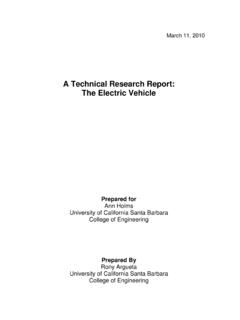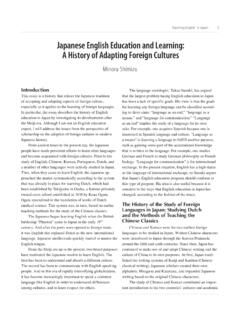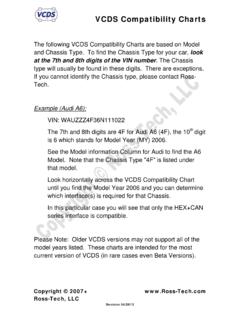Transcription of Applications – Chassis & Suspension – Suspension parts
1 Applications Chassis & Suspension Suspension parts Table of contents 2 Suspension Suspension control 5 Forged control 7 Control arms produced by semi-solid 12 Control arms produced by different casting 13 Control arms produced from extruded 16 Control arms produced from rolled 18 Assembled control 19 Knuckles (wheel/hub carriers).. 19 Example 1 - Rear arm and hub carrier 20 Example 2 - Front knuckle produced by permanent mould 21 Example 3 Permanent mould cast rear 21 Example 4 Permanent mould cast 22 Example 5 Axle support machined from an 23 Version 2011 European Aluminium Association 1 2 Suspension parts The Suspension includes the system of springs, shock absorbers and linkages which connect a vehicle to its wheels. The Suspension supports the weight of the vehicle body and also protects the vehicle and any cargo from damage and wear.
2 The purpose of an automobile's Suspension system is two-fold: passenger comfort and vehicle control, the Suspension system is the determining factor for active safety and driving pleasure. Comfort is provided by isolating the vehicle's passenger cabin from road bumps, vibrations, road noise, etc. Control is achieved by keeping the car body from excessively rolling and pitching, and maintaining good contact between the tyre and the road surface. These goals are generally at odds, so the tuning of the Suspension system involves finding the right compromise. Apart from the linkages, the fundamental components of any Suspension are springs, dampers and stabilizer (also called anti-roll) bars. Some aluminium components are found in springs and dampers, but the most important aluminium Applications are the structural Suspension parts , knuckles (wheel carriers) and control arms. For unsprung masses such as knuckles and control arms, lightweighting presents additional advantages.
3 Thus a reduction of the weight of the unsprung masses will also remain a most important driver for future developments. Stabilizers A stabilizer is usually a torsion spring that resists body roll motions. Its purpose is to prevent the car's body from "rolling" in a sharp turn. A stabilizer is generally constructed out of a U-shaped piece of steel that connects to the body at two points, and at the left and right sides of the Suspension . If the left and right wheels move together, the bar just rotates about its mounting points and does not bend. If the wheels move relative to each other, the bar is subjected to torsion and forced to twist. Some high-priced cars have also begun to use "active" anti-roll bars that can be automatically adjusted by a Suspension -control computer. The result is a reduced leaning of the body in turns while the rough-road ride quality of the vehicle is significantly improved. With respect to stabilizers, no specific aluminium Applications are known or can be foreseen today.
4 Springs Today's automotive spring systems are based on one of four basic designs: Coil springs Leaf springs (seldom used today) Torsion bars Air springs Torsion bar systems are most often found in the automobile. Torsion bars use the twisting properties of a steel bar to provide a coil spring-like performance. One end of the torsion bar is attached to the frame of the vehicle, the other end to a wishbone, which acts like a lever that moves perpendicular to the torsion bar. Air springs consist of a cylindrical air chamber that is positioned between the wheel and the car body. Air Suspension systems, which are typically found in the premium car segment, use compressed air as a spring. The air is pressurized by an engine-driven or electric air compressor. In terms of present and potential future aluminium Applications , only air Suspension systems have to be considered in more details.
5 Version 2011 European Aluminium Association 2 Air Suspension systems The air Suspension replaces the conventional steel spring system. Air Suspension systems are able to automatically adapt the damping and spring characteristics of the Suspension according to the preferences of the driver as well as to adjust the body level of the vehicle to changing driving conditions and loads. Due to their many advantages, air suspensions systems are more and more specified for future platforms. This is an important development trend as car manufacturers strive to improve gas mileage by weight reduction and thus utilize active Suspension technology to maximize the car performance. Electronically controlled air Suspension system with electrically actuated valves and integrated height and pressure sensors Source: ContiTech Apart from different components in the control unit, aluminium Applications in air Suspension systems include the air reservoirs which make the compressed air centrally available, but also various connection pipes with integrated flanges.
6 The currently applied pressure in air Suspension systems ranges from 10 bar to 25 bar, but the components achieve bursting pressures of up to 100 bar. Aluminium air cells offer top functionality, high gas tightness, excellent corrosion resistance and low weight. Tight space requirements can be fulfilled by the customer-specific development and fabrication of air cells in highly complex geometrical shapes. A unique example for an innovative optimisation of the installation space is the triangular air cell of the Audi A6 which is installed behind the back seat. Air cells for VW Phaeton (left) and Mercedes (right) Version 2011 European Aluminium Association 3 Source: SAG Motion AG Air cell for the air Suspension system of the Audi A6 (SAG Motion AG) Dampers Unless there is a dampening structure, mechanical springs would release the absorbed energy at an uncontrolled rate.
7 In practice, the unwanted spring motion is dampened by shock absorbers which slow down and reduce the magnitude of the vibratory motions by absorbing or dissipating the kinetic energy of the Suspension movement. Rubber bushings then absorb the rest of the vibrations. The sole purpose of the damper in any Suspension system is to control the oscillations of the springs, the weight of the vehicle is supported by the spring system. There are many types of shock absorber, but the most commonly used is the twin tube design which works with a hydraulic fluid (oil). It can be adapted to all types of Suspension . The upper mount of the shock absorber connects to the frame of the car ( the sprung weight), while the lower mount connects to the axle, near the wheel ( the unsprung weight). The energy of the spring is transferred to the shock absorber through the upper mount into a piston which sits in the inner (pressure) tube filled with hydraulic fluid.
8 Boreholes through the piston allow the fluid to leak through a series of compression valves as the piston moves up and down in the pressure tube. Since this process requires considerable force, there is a natural resistance to any rapid movement and the bouncing movement of the springs is outer (reserve) tube stores excess hydraulic fluid. Version 2011 European Aluminium Association 4 Lightweight shock absorbers with tubular aluminium housings Source: Aleris ZFSachs An automotive Suspension strut combines the primary function of a shock absorber with the ability to support sideways loads not along its axis of compression, thus eliminating the need for an upper Suspension arm. The most common Suspension strut in an automobile is the McPherson strut (see next chapter). Each wheel is attached to the car body by a McPherson strut which combines a shock absorber and a spring in a single unit.
9 Such an integrated shock-and-spring module offers better Suspension tuning abilities and a lower vehicle step-in height because of the altered Suspension geometry. This means that a strut must have a more rugged design, with mounting points near its middle for attachment of such loads. The substitution of steel by aluminium in the shock absorbers, which increasingly occurs in particular on car models with McPherson struts, saves 20-30% of the weight of the shock absorber. Premium cars with air spring systems are fitted with electronically assisted pneumatic shock absorbers which allow the air spring pneumatic pressure to automatically optimize the damping action under varying load conditions. In addition to providing improved vehicle handling and driving comfort for different load conditions, this system isolates the Chassis from the road and thus reduces the possibility of vibration damage. Suspension control arms The typical design elements of any modern Suspension system be it of the McPherson strut, trailing arm, multi-link or wishbone type - are the Suspension control arms.
10 The number of control arms in a vehicle depends on the type of Suspension . Version 2011 European Aluminium Association 5 The McPherson Suspension system, for example, consists of a wishbone (or a lower control arm stabilized by a secondary link) which provides a bottom mounting point for the hub of the wheel. This lower arm system controls both the lateral and longitudinal location of the wheel. The upper part of the hub carrier (or steering knuckle) is rigidly fixed to the strut. The strut Suspension includes also a steering arm which connects to the knuckle. The whole assembly is very simple and, since it eliminates the upper control arm, also allows for more width in the engine compartment. Another common type of a front independent Suspension is the double-wishbone Suspension . While there are several different possible configurations, this design typically uses two wishbone-shaped arms to locate the wheel.









